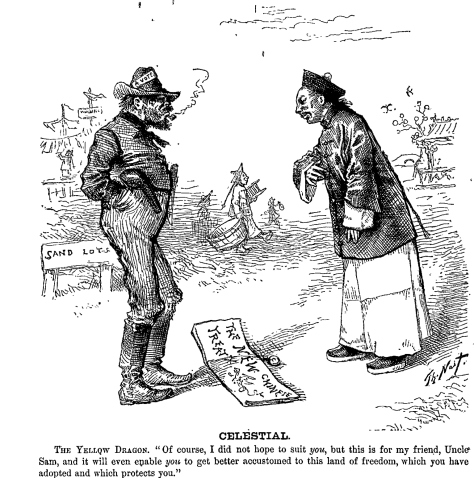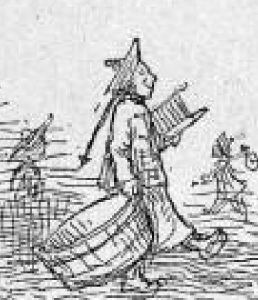
This small cartoon appeared on the back pages of Harper’s Weekly. Pre-Chinese Exclusion, the image reinforces stereotypes, both of the Chinese, here shown as “John Chinaman” and his nemesis, the white laborer, here a member of the Workingmen’s Party of California. This worker resembles Nast’s generic representations of Irish white laborers pressing the California public and legislature to legally and socially drive the Chinese out. The worker stands behind a sign that says “Sand Lots.” Sand Lots provided the stage where anti-Chinese agitator Denis Kearney popularized his anthem, “The Chinese Must Go” and rallied white laborers to organize themselves as the “Workingmen’s Party.”
The white laborer is scruffy and unkempt with an unflattering protruding jaw line. On his hat a band reads “A Vote.” He looks directly at the Chinese man. The outline of a cloud in the sky resembles smoke emanating from the man, but he is not smoking. Off in the distance, Chinese workers are traveling to and from a laundry.
Between the two men, a sign “The New Chinese Treaty” has fallen on the ground. The original Burlingame Treaty, enacted in 1868 to protect Chinese immigrants in the United States, and which bestowed most favored nation status to China, had since gone through many revisions, each increasing limitations upon the Chinese.
The Chinese man attempts diplomacy. He approaches his adversary with deferential respect, his hand to his chest in a slight bow. His head dips to acknowledge the working man. The caption reads,
“The Yellow Dragon. “Of course, I did not hope to suit you, but this is for my friend, Uncle Sam, and it will even enable you to get better accustomed to this land of freedom, which you have adopted and which protects you.”
Many Irish-born, anti-Chinese agitators, like Denis Kearney and the working men who followed him, were naturalized citizens and earned the right to vote in elections. The vote empowered the Caucasian laborers to lobby effectively against the Chinese. State and federal laws prohibited the Chinese from becoming citizens and voting.

In these smaller cartoons, Nast frequently shows Chinese figures carrying laundry tubs, washboards and engaging in laundry services. The Chinese did not come to America with any particular knowledge or skill of laundering, but they adopted the laundry industry as a practical matter when populations in western towns exploded. No one else wanted to do the work and it provided income to the Chinese while rendering a valuable service to the community. The availability of well-priced,Chinese laundry service freed white women from the tedious household task. A win-win situation for both white and Chinese families. The figure in the center is going about his business, with a smile upon his face.
Driven out of the mines and infrastructure jobs, Chinese moved into a wide variety of occupations that provided needed services. In addition to laundry, the Chinese were noted as shoe cobblers, cigar makers and tea merchants. Nast’s Chinese launderer may be seen as a stereotype, but by repeating this trope, Nast perpetuates another American perception about the Chinese – their docility.Whether intentional or not, Nast’s background images reinforces the Chinese as peaceful, non-threatening members of society.
Kearney and his his Sand Lot speeches were effective. Despite the Chinese’s limited presence in these service roles, Kearney’s Workingmen’s Party were nevertheless threatened by their existence. They demanded white households to boycott all services rendered by the Chinese.
In his cartoons, Nast alternated the placement of his signature. Here it is on the side of the Chinese diplomat. Plenty of room existed on the left to place the signature. There is evidence to suggest that Nast signed his name next to a person or cause to reaffirm an editorial position.


Why don’t you guys add colors in the picture
Many people have hand colored Harper’s Weekly drawing, including Nast’s work. As an academic project, I felt it was important to show them the way Nast drew them and presented them to the public.
But I might considered a hand-colored feature in the future, perhaps even my own! Thanks for the idea.